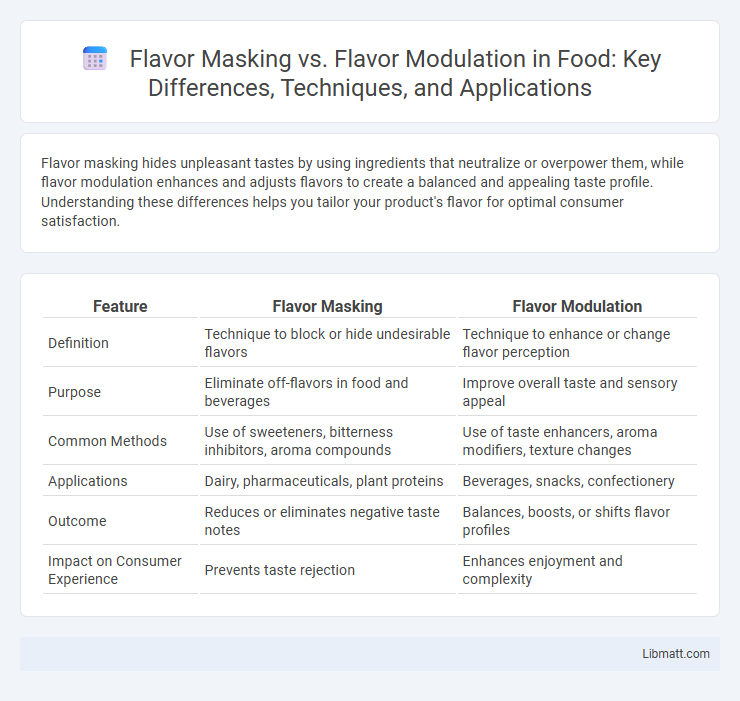Flavor masking hides unpleasant tastes by using ingredients that neutralize or overpower them, while flavor modulation enhances and adjusts flavors to create a balanced and appealing taste profile. Understanding these differences helps you tailor your product's flavor for optimal consumer satisfaction.
Table of Comparison
| Feature | Flavor Masking | Flavor Modulation |
|---|---|---|
| Definition | Technique to block or hide undesirable flavors | Technique to enhance or change flavor perception |
| Purpose | Eliminate off-flavors in food and beverages | Improve overall taste and sensory appeal |
| Common Methods | Use of sweeteners, bitterness inhibitors, aroma compounds | Use of taste enhancers, aroma modifiers, texture changes |
| Applications | Dairy, pharmaceuticals, plant proteins | Beverages, snacks, confectionery |
| Outcome | Reduces or eliminates negative taste notes | Balances, boosts, or shifts flavor profiles |
| Impact on Consumer Experience | Prevents taste rejection | Enhances enjoyment and complexity |
Understanding Flavor Masking and Modulation
Flavor masking involves concealing unwanted tastes by adding ingredients that neutralize or overpower specific flavors, while flavor modulation adjusts the overall flavor profile to enhance or balance taste perception. Masking targets specific undesirable notes, such as bitterness or off-flavors, whereas modulation focuses on creating a harmonious sensory experience by emphasizing desirable attributes like sweetness or aroma. Understanding these techniques allows you to optimize product flavor and improve consumer acceptance effectively.
Key Differences Between Masking and Modulation
Flavor masking involves completely hiding undesirable tastes using agents like sweeteners or emulsifiers, whereas flavor modulation subtly alters the perception of taste by enhancing or suppressing specific flavor notes through compounds such as aroma enhancers or bitterness blockers. Masking aims at neutralizing off-flavors to achieve a more palatable product, while modulation focuses on balancing and optimizing overall flavor profile without eliminating any component entirely. The key difference lies in masking's goal of concealment versus modulation's objective of refined flavor adjustment.
Importance of Flavor Masking in Product Development
Flavor masking is crucial in product development to effectively conceal undesirable tastes, such as bitterness or off-notes, ensuring consumer acceptance and satisfaction. Advanced flavor masking techniques improve the overall sensory profile without compromising the product's nutritional value or functional properties. Your ability to strategically implement flavor masking can significantly enhance product marketability and user experience.
How Flavor Modulation Enhances Taste Experience
Flavor modulation enhances the taste experience by dynamically altering perceived flavors through techniques such as ingredient interaction and controlled release of taste compounds. Unlike flavor masking, which simply hides unpleasant tastes, flavor modulation fine-tunes flavor profiles to amplify desired sensory attributes and balance overall taste perception. Your palate benefits from improved complexity and harmony, resulting in more enjoyable and memorable food or beverage consumption.
Techniques Used in Flavor Masking
Techniques used in flavor masking primarily involve the use of chemical agents such as cyclodextrins, which trap undesirable flavors, and flavor enhancers that suppress bitterness or off-notes. Encapsulation methods, employing liposomes or polymers, physically isolate unpleasant tastes to improve palatability. Your product's taste can be significantly improved by choosing the appropriate combination of these masking techniques tailored to specific flavor challenges.
Approaches to Effective Flavor Modulation
Effective flavor modulation involves techniques such as adjusting temperature, pH, and texture to influence flavor perception without altering the primary taste compounds. Approaches include using taste enhancers, aroma compounds, and chemical modulators that interact with taste receptors to enhance or suppress specific flavors. This strategy differs from flavor masking, which typically involves blocking or covering unwanted tastes, by instead reshaping flavor profiles to create desired sensory experiences.
Applications in Food and Beverage Industries
Flavor masking and flavor modulation play crucial roles in enhancing taste profiles within the food and beverage industries by addressing off-notes and improving overall sensory experience. Flavor masking targets the suppression or elimination of undesirable tastes, particularly in products like pharmaceuticals, nutritional supplements, and functional foods that may have bitter or metallic flavors. Flavor modulation adjusts flavor intensity or balance, often used in beverages, confectioneries, and snacks, to achieve a more appealing and palatable product for your consumers.
Challenges in Achieving Desired Flavor Profiles
Flavor masking involves covering undesirable tastes by adding agents that neutralize or overpower off-flavors, often facing challenges in balancing intensity without compromising the overall flavor profile. Flavor modulation adjusts the flavor perception through synergistic ingredient interactions, requiring precise formulation to enhance desired notes without introducing new unwanted flavors. Achieving the targeted flavor profile demands overcoming complexities related to ingredient compatibility, stability, and consumer sensory expectations.
Innovations in Flavor Masking and Modulation Technologies
Innovations in flavor masking and modulation technologies are transforming the food and beverage industry by enhancing product palatability without compromising nutritional content. Advanced encapsulation techniques and molecular binding agents effectively neutralize off-notes, while dynamic flavor release systems modulate taste perception over time. Your products benefit from these cutting-edge solutions, delivering improved consumer satisfaction through precise flavor control.
Future Trends in Flavor Science
Future trends in flavor science emphasize innovative approaches in flavor masking and flavor modulation to enhance consumer sensory experience without compromising product health profiles. Advances in biotechnology and natural ingredient extraction are driving the development of more effective, targeted flavor masking agents and dynamic modulation systems that adapt in real-time to taste perception. Integration of AI and sensory analytics enables precise customization of flavor profiles, promoting personalized nutrition and reduced use of artificial additives.
Flavor Masking vs Flavor Modulation Infographic

 libmatt.com
libmatt.com